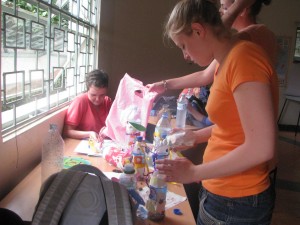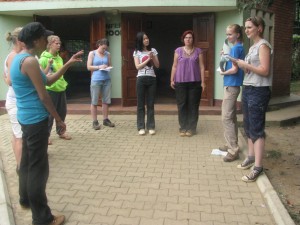Lets plan activities and understand more about primates!
 Today was an important day as we were planning activities for the children from the orphanage who are visiting us all weekend. The activities planned were art, music and drama. There are 43 children in the orphanage and they have been split into 3 age groups for the activities, so members of Yebo could concentrate on finding out more about individual personalities. We have organised it so each child can find out about different chimps with similar personality traits and who have been through similar traumas.
Today was an important day as we were planning activities for the children from the orphanage who are visiting us all weekend. The activities planned were art, music and drama. There are 43 children in the orphanage and they have been split into 3 age groups for the activities, so members of Yebo could concentrate on finding out more about individual personalities. We have organised it so each child can find out about different chimps with similar personality traits and who have been through similar traumas.
All of the volunteers have some great ideas and all put in their creativity as the activities were planned out. It was a lot of fun combining the information we had learnt about the chimpanzees to the children we would be working with, linking their circumstances together. When planning some of the activities we also had to be aware of sensitivity, and the impact that we would be having on the children through these. The activities had to be non-direct and non-intrusive from us as volunteers, allowing the children to use their own ideas and expressions when taking part in them, as well as letting their carers from the orphanage speak to them more about what they had learnt and more in depth if they felt this was appropriate. 
All the volunteers had very generously brought with them art materials that could be used with all the activities. We also had brought some extra paints etc. Planning the activities to suit the children once they returned home to their orphanage was also important, making sure they were able to use recycled material that they would be able to have around them, as they do not usually have access to paints, pens, glitter, glue etc. Many of the ideas came from using ‘rubbish’ such as cardboard boxes, old plastic bottles, tin cans, shoe laces, materials etc. When planning activities the items used have to be chosen carefully so the children are able to make these at home.
In the afternoon we were involved with chimpanzee observation with one of the main keepers, Helen. She used feeding to help us identify different members of the group of chimpanzees. For example, we could recognise the alpha male as when food was thrown onto their island by the keepers, the other chimps left the food alone until he had had his share.
 It was great to be able to see how the chimpanzees interacted, and as their keeper, Helen, was there they were more than happy to stand around for us to observe them.
It was great to be able to see how the chimpanzees interacted, and as their keeper, Helen, was there they were more than happy to stand around for us to observe them.
Everything that we had learnt the previous day on Ngamba island could then be used, with extra questions that we wanted to ask this afternoon. The stories that had been given to us the day before on 3 individual chimps, were chimpanzees from UWEC, so we were now able to see these chimps and observe them for ourselves. Knowing more about their background we were able to relate much better to them, instead of just seeing them once. 
We were able to start learning their different forms of communication, the noises that they make and also the threats that they have faced in the wild. This also helps us on a level of primate conservation. We see this as a different form of learning about it rather than just reading it in a book or seeing it on a blackboard. Having an understanding of the chimps in this way, helps us to learn, and of course, really care, about what is going on for them in the wild.
After a great day, we had a great time in the evening, as we all sat down after a delicious meal of sweet potatoes and curry and had a few beers and merry chit chat!
By Roger Mallins, July 22, 2010 @ 10:31 am
Music Drama and Art perfect harmony!